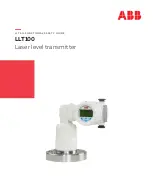
5
4. Mounting and installation
4.1 A measuring point consists of the following components:
•
1 x Transmitter unit
•
1 x Receiver unit
•
2 x lock nut for locking transmitter and receiver unit
•
2 x G-1½”-socket for mounting the unit
•
1 x manual
4.2 Required equipment
•
Certified tools for electrical connection
•
60 mm open-ended spanner for lock nut
•
Teflon tape to ensure tightness
4.3 Sensor installation
Proceed as follows to install the sensor:
•
Define a location with as little vibration as possible.
•
A distance of 15 cm to adjacent walls is recommended.
•
Weld the sensor sockets, that the transmitter and receiver face each other with their front sides in the
same level.
•
It is imperative that the sensor socket is free of dirt and deposits.
•
If the measuring point is not directly installed, the sensor sockets can be closed with a cap with G-1½”
thread.
•
It is important to ensure that the transmitter and receiver are given the same orientation and are aligned
precisely to each other. (Polarization sticker)
•
After successful alignment transmitter and receiver unit must be locked with the lock nut.
•
A maximum distance between sender and receiver of 25 m must not be exceeded.
•
If transmitter and receiver can not be installed facing each other, installation on one side is possible (Fig. 2).
•
If the material to be measured has a low bulk density or low DK value, the transmitter and receiver can
be mounted on one side of the pipe (Fig. 2).
Fig. 2: Installation on one site of pipe
Round wall (metallic)
Rectangular wall (metallic)




















